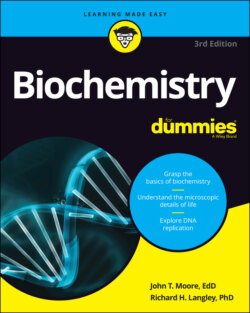Читать книгу Biochemistry For Dummies - John Moore T., Richard Langley H., John T. Moore - Страница 20
Achieving equilibrium
ОглавлениеWhen the concentrations of hydrogen ions and hydroxide ions are the same, a solution is neutral. If the hydrogen ion concentration exceeds the hydroxide ion concentration, the solution is acidic. If the hydroxide ion concentration is greater, the solution is basic. These ions are related through a chemical equilibrium.
Acidic solutions, such as lemon juice, taste sour. Basic solutions, such as tonic water, taste bitter. (The addition of gin doesn’t change the bitter taste!)
The equilibrium of hydrogen ions is present in all aqueous solutions. Water may or may not be the major hydrogen ion source (usually, it isn’t). Water is a contributor to the hydrogen ion concentration because it undergoes autoionization, as shown by the following equation:
You often see represented as .
The double arrow indicates that this reaction (represented by the equation) is an equilibrium; as such, there must be an associated equilibrium constant (K). The equilibrium constant in the preceding equation is Kw. The value of Kw is the product of the concentrations of the hydrogen ion and the hydroxide ion:
The value of the constant Kw, like all Ks, is only constant if the temperature is constant. In the human body, where , .
In pure water, at 25°C, . The hydroxide ion concentration is the same as the hydrogen ion concentration because they’re formed in equal amounts during the autoionization reaction. Keep in mind that only in pure water.
M is a concentration term, the molarity. Molarity is the number of moles of solute per liter of solution.
